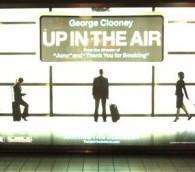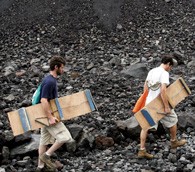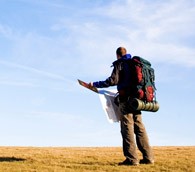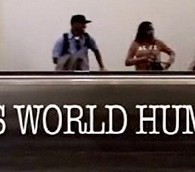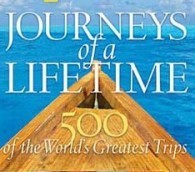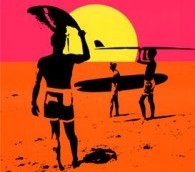Tag: Wanderlust
Is the ‘Madness’ of Travel in our DNA?
by Michael Yessis | 09.07.11 | 10:49 AM ET
Elizabeth Kolbert’s New Yorker story about Svante Paabo’s quest to sequence the Neanderthal genome contains a theory about why humans travel and seek the unknown. Kolbert notes that the archeological record shows Neanderthals’ migration stopped “when they reached water or some other significant obstacle,” while “archaic humans” pushed past those barriers, across open water and beyond. Paabo, writes Kolbert, seeks to “identify the basis for this ‘madness’ by comparing Neanderthal and human DNA.”
Paabo explains:
It’s only modern humans who start this thing of venturing out on the ocean where you don’t see land. Part of that is technology, of course; you have to have ships to do it. But there is also, I like to think or say, some madness there. You know? How many people must have sailed out and vanished on the Pacific before you found Easter Island? I mean, it’s ridiculous. And why do you do that? Is it for the glory? For immortality? For curiosity? And now we go to Mars. We never stop.
He adds:
If we one day will know that some freak mutation made the human insanity and exploration thing possible, it will be amazing to think that it was this little inversion on this chromosome that made all this happen and changed the whole ecosystem of the planet and made us dominate everything.
He also tells Kolbert:
We are crazy in some way. What drives it? That I would really like to understand. That would be really, really cool to know.
Fascinating.
Unfortunately, only an abstract of the story is online. There is, however, a Q&A with Kolbert.
Video: ‘The Sinner’s Grand Tour’
by Jim Benning | 08.31.11 | 3:39 PM ET
Traveler and historian Tony Perrottet discusses his latest book, The Sinner’s Grand Tour, and one of his most exciting discoveries:
What Does it Mean to be a Nomad?
by Michael Yessis | 08.12.11 | 11:26 AM ET
Venkatesh Rao calls herself an “illegible person.” She explains:
My temporary nomadic state is just one aspect of a broader fog of illegibility that is starting to descend on my social identity. And I am not alone. I seem to run into more illegible people every year. And we are not just illegible to the IRS and to regular people whose social identities can be accurately summarized on business cards. We are also illegible to each other. Unlike nomads from previous ages, who wandered in groups within which individuals at least enjoyed mutual legibility, we seem to wander through life as largely solitary creatures. Our scripts and situations are mostly incomprehensible to others.
“Wanderlust” author Elisabeth Eaves calls Rao’s essay the “best thing I’ve read on nomadism since Bruce Chatwin.”
Rao means something else too: As nomads, we become illegible to a system that can’t pin us down by income, residence, or occupation. Governments and corporations begin to see us as either irrelevant or suspicious. I like to think I’ve contributed a little to this subject in “Wanderlust,” when I talk about stationary peoples’ mistrust of the nomad. The great work on this theme is Chatwin’s “The Songlines.”
(Via @ElisabethEaves)
Interview with Elisabeth Eaves: ‘Wanderlust’
by Eva Holland | 07.01.11 | 9:25 AM ET
Eva Holland talks to the author about the intersection of lust and wanderlust in her new book
10 Wanderlust-Inducing Travel Novels and Story Collections
by Frank Bures | 06.29.10 | 3:11 PM ET
Frank Bures on the books to read when you're seeking inspiration
Interview With Amanda Pressner: A Year of Getting Lost
by Michael Yessis | 05.27.10 | 12:26 PM ET
Michael Yessis talks to one of the authors of "The Lost Girls" about long-term travel and its unforeseen rewards
Beyond Airworld
by Rob Verger | 12.11.09 | 10:19 AM ET
"Up in the Air" illuminates the bittersweet challenge of the traveler's life. Rob Verger explains.
How Habitual Travel Sharpens the Intellect
by Michael Yessis | 10.07.09 | 1:12 PM ET
Travel can lead to disorientation, which can improve learning. Benedict Carey explains.
Found: A New ‘Wanderlust Gene’
by Michael Yessis | 08.07.09 | 9:03 AM ET
Scientists at the University of British Columbia identified it in the stickleback fish, which, of course, is now my all-time favorite fish. Wondering about a wanderlust gene in humans? Scientists may already have discovered that, too.
Scent and Travel, Continued
by Michael Yessis | 07.22.09 | 10:41 AM ET
Here’s another fine addition to the ongoing conversation about the power of scent in travel: Jenna Schnuer’s The Great Scent Escape. “So, perhaps, scent is a secret key back to places we love,” she writes.
Seven Images to Inspire Wanderlust: From Nicaragua to New Delhi
by World Hum | 06.05.09 | 9:26 AM ET
Indulge your armchair traveler with seven wanderlust-inspiring travel photos from around the world
See the full photo slideshow »
Why We Travel
by Pico Iyer | 04.27.09 | 11:47 AM ET
In a classic essay, Pico Iyer explores the reasons we leave our beliefs and certainties at home to see the world with open eyes
Inside World Hum 3.0
by World Hum | 12.11.08 | 4:39 PM ET
World Hum cofounders Jim Benning and Michael Yessis, and editor Valerie Conners, discuss the site's new look.
World Hum’s Most Read: Nov. 29-Dec. 5
by World Hum | 12.05.08 | 3:43 PM ET
Our five most popular dispatches for the week:
1) Six Degrees of Vietnam
2) How Low Can You Go?
3) The Art of Writing a Story About Walking Across Andorra
4) Lesson at the Laverie
5) Another Tet Offensive
China: Not a ‘Pseudo-Place’
by Eva Holland | 11.13.08 | 12:00 PM ET
When The Smart Set’s Paula Marantz Cohen headed off on a two-week organized tour of China, she expected to experience one of the tourism industry’s manufactured “pseudo-places,” as Paul Fussell calls them. That is, “tourist commonwealths, whose function is simply to entice tourists and sell them things.” But as she explains in this thoughtful essay, she was mistaken.
Feasting in Lyon
by Jeffrey Tayler | 09.30.08 | 9:08 AM ET
Jeffrey Tayler feared he would never feel as intoxicated with the sense of discovery as he once did. But something clicked when he set foot in France's third-largest city.
World Hum Travel Movie Club: ‘Into The Wild’
by Eli Ellison, Eva Holland | 03.04.08 | 11:44 AM ET
By now, you know the story. In 1990, a 22-year-old college grad named Christopher McCandless renounced his privileged upbringing, adopted the nom de drifter Alexander Supertramp, and turned to a new life of vagabonding. Two years later, Alaskan moose hunters found his corpse in an abandoned Fairbanks city bus outside Denali National Park. Jon Krakauer pieced together Chris’s odyssey and wrote the bestseller Into the Wild. Sean Penn‘s movie version of the book, which hit theaters last fall, arrives today on DVD. Eva Holland and Eli Ellison gave the disc a spin, exchanged e-mails and debated Hollywood’s adaptation of Into the Wild in the debut of the World Hum Travel Movie Club.
1,000 Places to Not go Before You Die
by Frank Bures | 10.17.07 | 8:21 AM ET
"Journeys of a Lifetime: 500 of the World's Greatest Trips" and "Make the Most of your Time on Earth: 1000 Ultimate Travel Experiences" are gorgeous, transformational and, ultimately, full of empty promises. Frank Bures explains why travel list books often end up coated in dust.
‘The Condé Nast Traveler Book of Unforgettable Journeys’
by Tyler D. Johnson | 10.05.07 | 10:23 AM ET
A new anthology gathers some of the most memorable stories from the magazine's 20-year history. Tyler D. Johnson says it contains the humor and wisdom only travel can deliver.
The Enduring Appeal of ‘The Endless Summer’
by Jim Benning | 12.11.06 | 1:52 PM ET
The classic surf film celebrates its 40th anniversary this year. Its popularity lives on, Jim Benning writes, because it's one of the greatest wanderlust-inducing documentaries ever made -- and a potent antidote to winter.
- « Prev Page
- Next Page »



